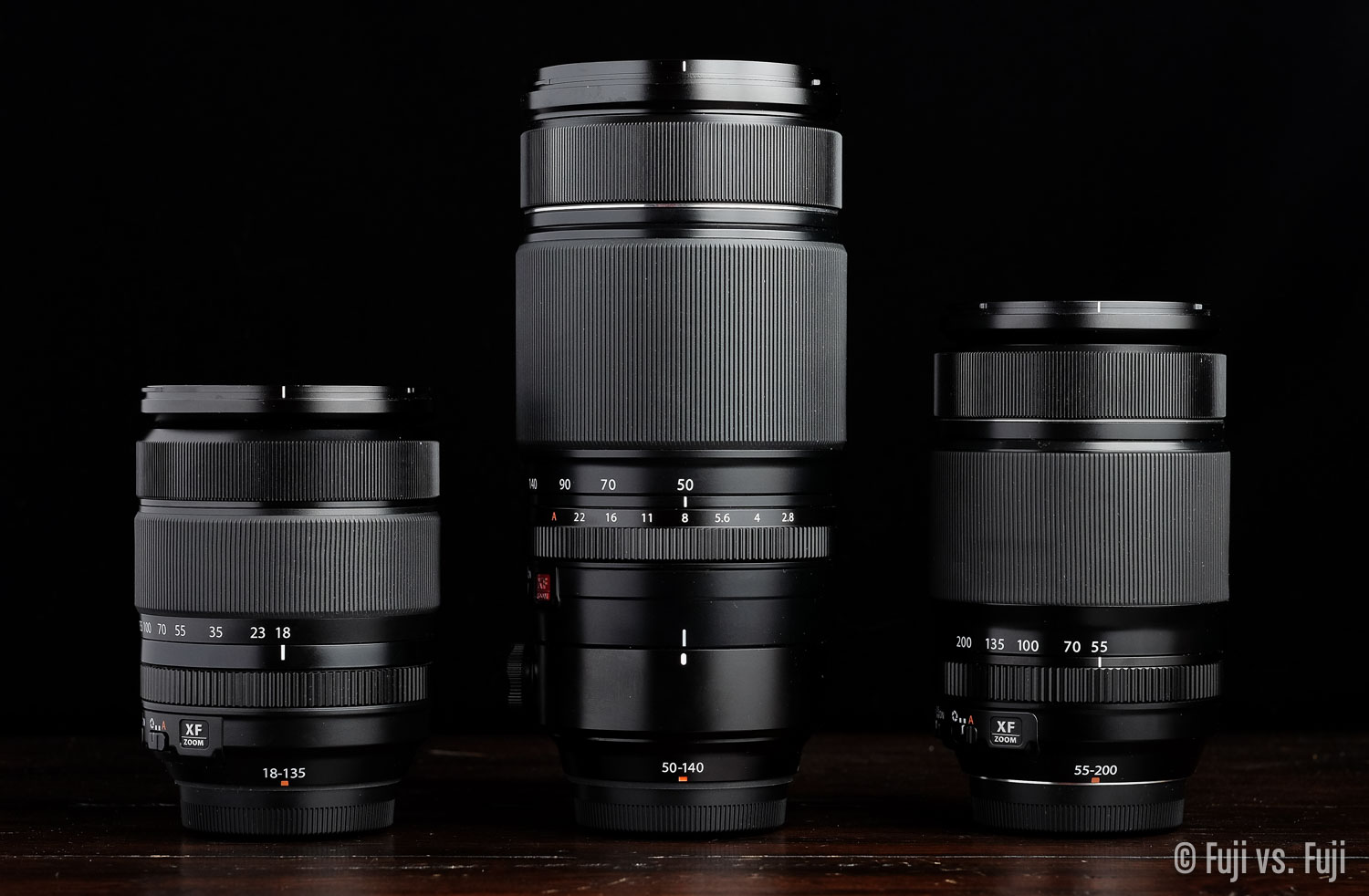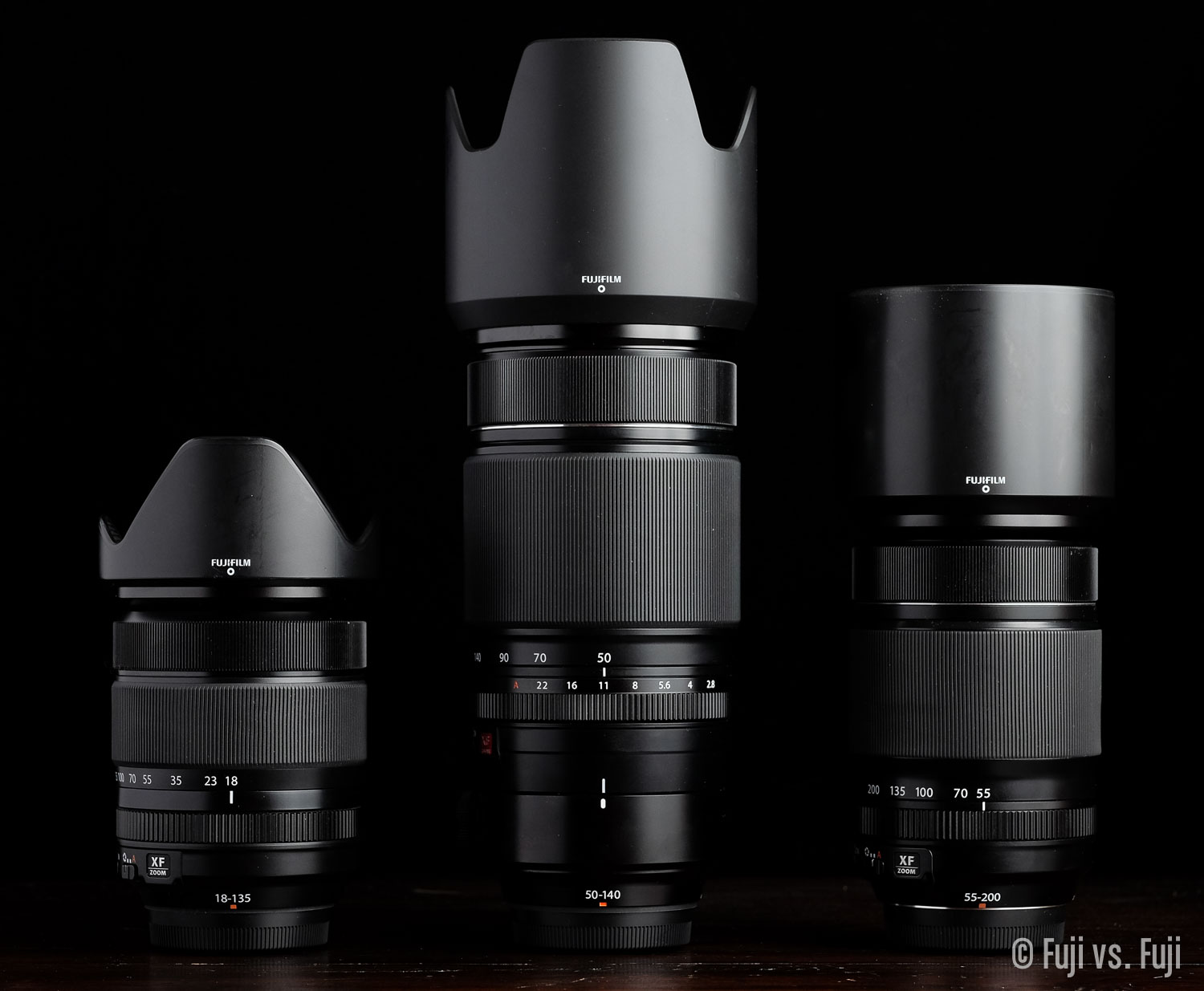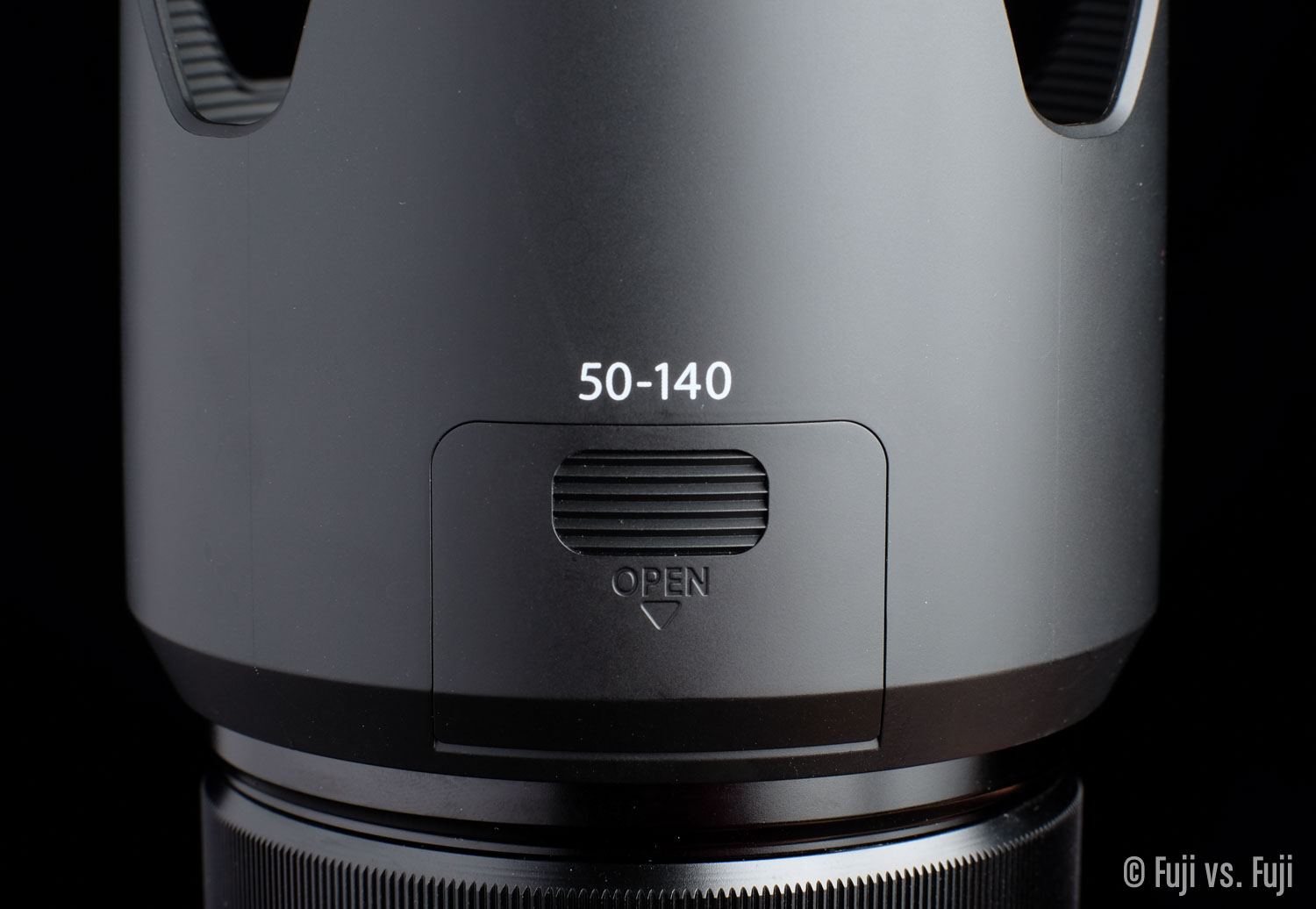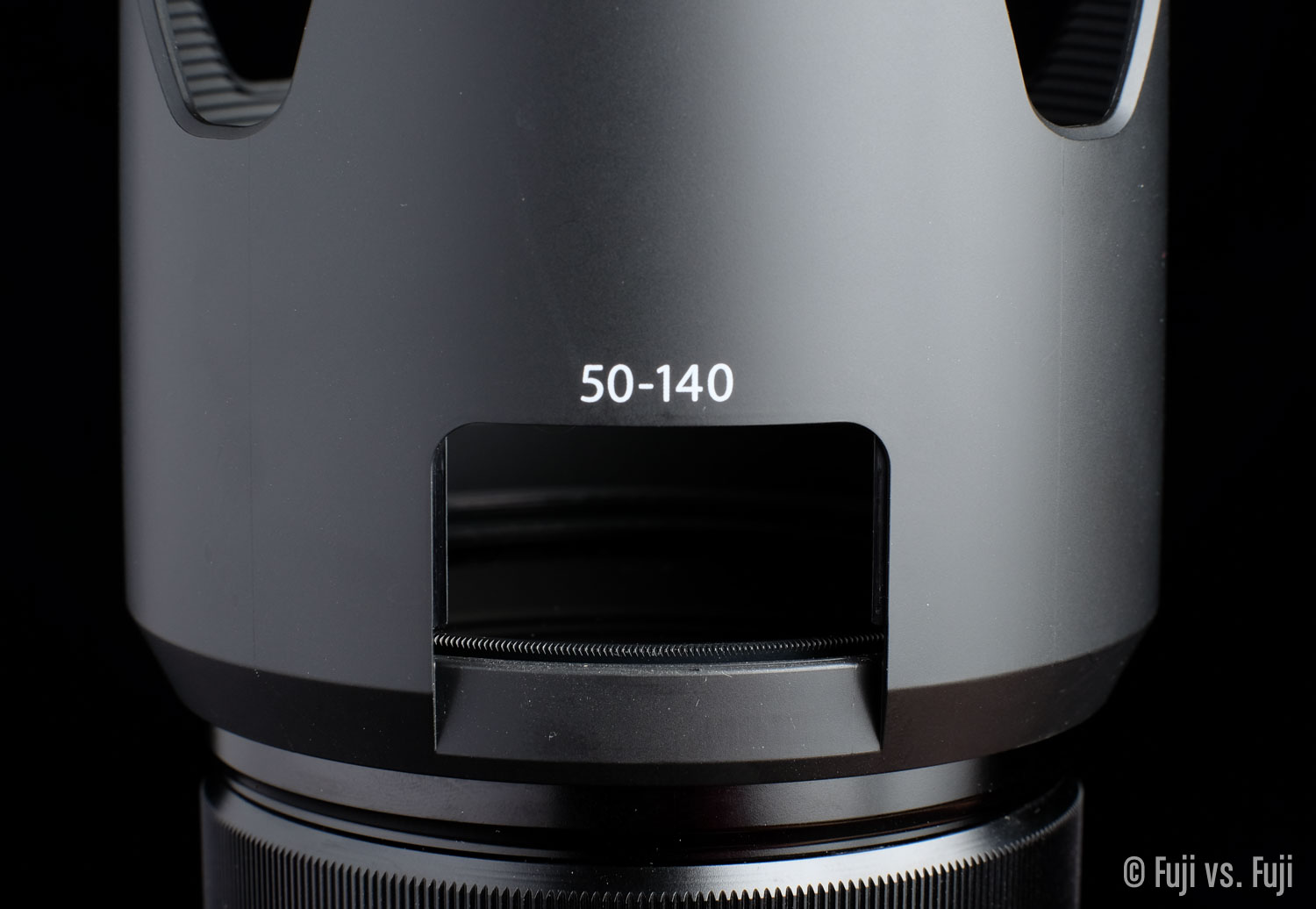Fujifilm XF 18-135mm F3.5-5.6 OIS WR vs. XF 50-140mm F2.8 OIS WR WR vs. XF 55-200mm F3.5-4.8 OIS, a comparison of Fuji’s telephoto zooms.
February, 2015: Originally published
Introduction
Before the release of the XF 50-140mm F2.8 OIS WR—Fuji’s Red Badge equivalent of the venerable 70-200mm zoom—telephoto zoom lenses were decidedly more casual. The XF 55-200mm F3.5-4.8 OIS features a relatively slow variable aperture in favour of a more compact size, and the XF 18-135mm F3.5-5.6 OIS WR is a “super zoom” geared at travel photographers.
The XF 50-140mm F2.8 OIS WR has a significantly more “pro” feel to it. In this comparison, we’ll see if that pro build quality translates to higher fidelity images.
Specifications
| XF 18-135mm | XF 50-140mm | XF 55-200mm | |
|---|---|---|---|
| Announced | June 16, 2014 | September 10, 2014 | April 17, 2013 |
| Released | August, 2014 | November, 2014 | June, 2013 |
| Price (MSRP) |
$899 | $1,599 | $699 |
| Lens Construction | 16 elements, 12 groups 4 aspherical elements, 2 anomalous dispersion lenses |
23 elements, 16 groups 5 extra low dispersion elements 1 super extra low dispersion element |
14 elements, 10 groups 1 aspherical, 2 extra low dispersion |
| 35mm Equivalent | 27.36 - 205.2mm | 76 - 212.8mm | 83.6 - 304mm |
| Angle of View | 76.5° - 12° | 31.7° - 11.6° | 29.0° - 8.1° |
| Aperture Range | f/3.5 - f/5.6 | f/2.8 | f/3.5 - f/4.8 |
| Focus Range | 0.45m - Infinity | 1.0m - Infinity | 1.1m - Infinity |
| Maximum Magnification | 0.27x | 0.12x | 0.18x |
| External Dimensions | 75.7mm diameter x 97.8mm - 158mm long | 82.9mm diameter x 175.9mm long | 75mm diameter x 118mm - 177mm long |
| Weight (Measured) | 486g 530g with caps and hood |
1,092g 1,184g with caps and hood 1,224g including collar Arca Swiss adapter |
566g 633g with caps and hood |
| Filter Size | 67mm | 72mm | 62mm |
Features
| XF 18-135mm | XF 50-140mm | XF 55-200mm | |
|---|---|---|---|
| Constant Aperture | No | Yes | No |
| Image Stabilization | Yes | Yes | Yes |
| Weather Sealed | Yes | Yes | No |
| Nano GI Coating | No | Yes | No |
| Brass Mount | No | Yes | No |
Handling and Build Quality
Rings and Switches
The 18-135mm f/3.5-5.6 and 55-200mm f/3.5-4.8 handle essentially the same as zooms that came before them. Same unmarked aperture ring, same switch to select Aperture Priority, same OIS switch, same rubberized zoom ring, and same manual focus ring. The two key visual differences of note between the zooms are the XF 55-200mm f/3.5-4.8 not having a rubberized zoom ring,1 and the 18-135mm f/3.5-5.6 missing the thin chrome band between the zoom ring and the manual focus ring. I actually thought it had been missed during assembly on the sample I have.
The 50-140mm f/2.8 is essentially the same as far as components go, with the exception being that it has a marked aperture ring.
Perceived Weight
Visuals aside, there’s a noticeable difference in the feel of the 50-140mm f/2.8. It can be summed up in a single word; heavy. Everything about the lens has more of a weight to it. The aperture ring doesn’t “click” so much as providing a satisfying “clunk” when changing the aperture. The same is true for the zoom ring, in that it has been dampened in a way that seems to assist the photographer in turning it, once it has been engaged. This isn’t to say the zoom ring moves on its own—quite the contrary—but if you’ve used a pro zoom from Canon or Nikon, Fuji’s 50-140mm f/2.8 will feel very familiar. In my opinion, the 50-140mm feels better than either the 14-24mm or 24-70mm I had from Nikon, both of which had a slightly rough feel to their zoom rings.
Actual Weight
With all that subjectivity out of the way, let’s have a look at real measurable weight. In addition to the more weighted feel of its handling, the 50-140mm f/2.8 is also just plain heavy when compared to the other lenses that cover (most of) its zoom range. In your bag with its caps and hood, it’s well over twice as heavy as the 18-135mm f/3.5-5.6, and almost twice as heavy as the 55-200mm f/3.5-4.8. The good news is both those lenses are reasonably light.
Weight
Hand-holding
When cradled in the left hand, the huge zoom ring is perfectly accessible, and turns with the exact right amount of effort. Depending on the size of your hands, the manual focus ring is also probably within reach. The aperture ring is nice and tight, and satisfyingly clicky (or clunky). It won’t move out of place, even if the ring is where you’re cradling the lens. I use the word “clunky” in the best possible way. It’s like the feel of a good car door closing, or the dial on an expensive A/V receiver.
A final note on zooming, my copy of the 50-140mm has a bit of a hiccup or subtle click in the zoom just a little past 50mm. It doesn’t affect the functionality at all, but it’s there and I wondered about it.
Internal vs. External Zoom
I’ve never been a big fan of zoom lenses that telescope too far, so I appreciate the fully internal zoom range of the 50-140mm f/2.8. The internal zoom likely contributes a great deal to the superior feel of the zoom ring.
Both the 18-135mm f/3.5-5.6 and 55-200mm f/3.5-4.8 telescope. A lot. One must take care not to smack the end of the lens too hard when it’s fully extended, as they’re likely to damage the lens and degrade the image quality to unusable levels. I’ve handled one of these lenses where this has happened. Add the hood the 55-200mm f/3.5-4.8 and it starts to feel like a long stick comprised of small sticks that have been tied together with string.
Lens Hoods
The newer 50-140mm f/2.8 and 18-135mm f/3.5-5.6 both come with scalloped lens hoods. The hood found on the 18-135mm is almost certainly less optimal by virtue of the huge range it provides, but it’s the most manageable in terms of size.
The 50-140mm’s hood is a monster. It’s solid, but huge. I’ve seen complaints about it being plastic, but I don’t have a problem with it. It’s light and durable so I’m not worried about dropping it. Metal hoods dent real easy and black paint reveals the aluminum underneath even easier. Perhaps the nicest part about the 50-140mm’s hood is the slot that allows for filter access. Circular polarizers have always been a pain with hoods, but this little slot makes adjusting it much easier. This needs to be on every hood possible. I would buy a second aftermarket hood for many of my lenses.
The hood for the 55-200mm f/3.5-4.8 shades the lens very well. It too is on the large side, but it’s much less bulky than the 50-140mm’s.
Lens Caps
It’s probably a long shot, but I can’t help but wonder if someone in Japan noticed I prefer Nikon’s lens caps and actually buy replacement caps for all my Fuji lenses. Yeah, they probabaly didn’t. Either way, the new caps found on both the 50-140mm f/2.8 and the 16-55mm f/2.8 are awfully Nikon-like in how they’ve changed. I really like these caps, and won’t be replacing them.
You might think I’m being petty with this lens cap thing, but the added depth of the cap around the outside makes a huge difference in how easy it is to remove the caps quickly. Even my wife who is decidedly less fussy about this sort of thing prefers a Nikon cap to the caps that previously shipped with Fuji cameras. The new caps also attach more securely. Really nice.
Tripod Collar
Only the 50-140mm ships with a removable tripod collar. It has a great feel to it, but I have been struggling a little with movement of my camera with this lens mounted and using a tripod. It’s not that it isn’t solid, but there is some flex to it that is amplified by anything else in your support system that might be unstable. In my case, shooting with the quick column of my tripod fully extended creates a small amount of instability with a lens of this weight mounted to it. This makes capturing critically sharp photos tough. So prepare to up your shooting discipline if you want to capture exposures of any length with this lens. High winds could be out of the question unless your whole set-up is rock solid, or low to the ground.
Optical Image Stabilization (OIS)
Fuji took image stabilization to another level with the 50-140mm f/2.8. I’ve managed to hand hold exposures as long as ⅛ of a second at 140mm and achieve a sharp image. Not every time of course, but it’s possible. As a comparison, I used to brace myself against a tree to steady myself trying to capture a shot at ⅛ using an ultra-wide angle lens without any image stabilization, and got about as many usably sharp exposures.
I’m not going to test the exact number of stops it saves you (Fuji claim 5, up from 4.5 on previous versions), but given I can focus on something and deliberately jiggle the camera and see little if any movement in the viewfinder, I’d say it works as advertised. It’s crazy how good the OIS is.
The OIS in the 50-140mm does come with one minor penalty; noise. It engages and disengages with a clunk, hisses during camera operation, and emits a mechanical squeaking noise as the lens lets go of what it was trying to stabilize and grabs onto the next point of focus. In a quiet room the OIS turning on and off is probably more audible than the shutter. You can hear an audio sample below. The hiss is more like pink noise, only noticeable when it’s gone, and I doubt the squeaking would be heard by anyone other than the camera operator. Outside of quiet rooms, it’s a non issue. The comically loud slap of a DSLR mirror would drown any noise from a Fuji camera by a factor of 10.
I was going to post the OIS audio from other lenses with the feature, but the sound is so minimal, it really isn’t worth posting. The 50-140mm f/2.8 is in a league of its own in that regard.
Lens Mount
The 50-140mm f/2.8, along with its Red Badge sibling, the 16-55mm f/2.8 has a brass lens mount “for improved strength.” You can see the difference in the finish below. I’ll have to take Fuji’s word for it that this mount is indeed stronger. I won’t try to rip the lens away from its mount.
Body Pairing
The 50-140mm f/2.8 is heavy enough that unless you’re planning on having it on a tripod via it’s collar, the added grip of the X-T1 will really help you. X-E or X-Pro1 users can definitely use the 50-140mm with it cradled in their left hand, but they will always want it to be a two-handed affair. On an X-T1, it can be held with one hand, but you can forget about shooting that way. There’s only so much that OIS can do. The camera and lens lay flat nicely with an L-plate attached to the body, and the whole package can sit on the collar foot.
As for the other two lenses, you can pretty much take your pick on the body you mount them on. For me, large lenses like these feel wrong on the X-E bodies or even X-Pro1, which both seem to beg for primes, but that’s just a silly preconceived notion thanks to rangefinder cameras of yore. The 55-200mm f/3.5-4.8 probably makes the most sense on an X-E body, since it’s a bit of a shame to have a weather sealed lens like the 18-135mm f/3.5-5.6 on a body that isn’t.
Bottom line on body pairing, take your pick, but the X-T1 will handle just a little bit better with all 3 lenses, and provide complete weather sealing with two.
Image Quality
Alright, let’s get to the good stuff. First, I need to apologize for how uninspired some of these test shots are. I haven’t had much luck with getting better than cold, dreary, grey days for pretty much the month of February. Such days can certainly make for great photographs, but leave me wanting when it comes to test images.
Bokeh – Grey Skies
The trees in the busy background of this image provide an excellent comparison for how well these lenses can separate your subject. The immortralization of Marcia and Alex’s love, “4 Eva,” is also an excellent sharpness comparison.
Wide Open
First up, we’ll look at each of the lenses at their largest aperture. The 18-135mm and 55-200mm were both set to approximately 135mm, and the 50-140mm racked out the 140mm.
There can be little debate which lens comes out on top here. The 50-140mm f/2.8 is unquestionably superior. Between the other two lenses the fight is a little more fair, but extra ⅔ of a stop the 55-200mm f/3.5-4.8 has results in creamier bokeh. For whatever reason, the 55-200mm has produced an image with a more green tint to it, despite the white balance for all images being manually set.
Detail
Where things get really interesting is how well these lenses hold detail at their widest aperture. Click to enlarge these ones.
The plane of focus shifted slightly between lenses, but it’s pretty clear the pro zoom clobbers the 18-135mm and 55-200mm in wide open performance.
f/5.6
Next we’ll level the playing field, and capture (roughly) the same at the same aperture.
Things get quite a bit more even. I might have to hand it to the 55-200mm f/3.5-4.8 overall here, but it’s a close call.
Bokeh – Blue Skies
A second option for the bokeh fans out there. The 50-140mm f/2.8 is definitely capable of melting those busy background away better than the other two.





























